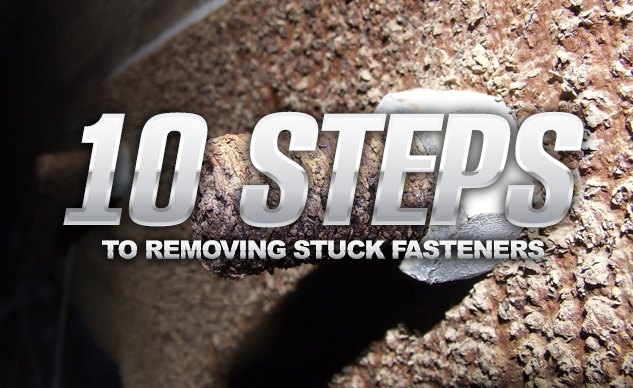10 Steps to Removing Stuck Fasteners

Now you’re in a pickle! You thought that with just a little more effort the bolt would turn. It did – only the head twisted off in the process. Perhaps, instead, the corners of the bolt are rounded beyond recognition. Or maybe you just stripped the phillips out of the phillips head screw. Regardless, the fastener is damaged beyond repair. What do you do now?
Home mechanics have a long history with breaking bolts or stripping heads or having a fastener simply refuse to budge. Although the pros may mock the less experienced, amateur wrenches, here’s a little secret: They mangle fasteners, too. What sets them apart is that they know how to get themselves out of the hole they’re in (mostly) without digging it any deeper.
10. Use Your Mind Before Resorting To Muscle
The natural response, when encountering a stubborn fastener, is entering into an escalating battle of wills. A good rule of thumb is: If you’re breaking a sweat, you’re doing something wrong. So, before reaching for that three-foot breaker bar for “just a little more leverage,” pause for a moment to ponder the offending part. Is it corroded? Perhaps you should clean it with a wire brush, apply some penetrating oil (like Liquid Wrench), and then shock the threads with a hammer blow to the bolt head. Is the bolt binding up after turning a little? Treat the bolt like a tap and screw it back in an eighth turn after every quarter turn out until it frees up. And apply more penetrating oil. Could the fastener be held in place by permanent Loctite? Heat, followed by a hammer shock, could help.
9. Go Old School
8. Give It A Rap With A Hammer
Okay, so we’re getting to an action that will feel good to perform. Giving a stuck fastener a nice rap with a hammer can shock the corrosion or thread-locking agent that is preventing the bolt from spinning free. Still, you gotta use your noggin’ and not go all neanderthal on the part or you risk creating even more damage than you already have. Again, you’d be surprised how often this works.
7. Use An Impact Driver
While bike manufacturers don’t use phillips head screws on engines as much as they used to, the home mechanic can still run into them on occasion. When phillips heads get munged up, use an impact driver. Impact drivers take a hammer blow and turn it into rotational force. So, when you hit it with a hammer, the screwdriver tip is jammed into the screw head, creating a tighter mechanical bond between the tip and the screw at the same time that impact driver attempts to rotate the screw. There is something quite satisfying about banging on an impact driver with a hammer and watching the screw begin to turn. This can also be done to bolts, provided you have hardened sockets. (Regular sockets can shatter.)
6. Grab On To Those Rounded Corners
All too frequently, the offending nut or bolt has had its corners rounded in the attempts to free it. This usually occurs when using the wrong size or inferior wrenches (like those included in the stock tool kit) or attempting to remove a nut with an inappropriate tool, say a pair of locking pliers. If this is the reason for your predicament, while at the store buying Craftsman’s Bolt Out or a similar product from another manufacturer, buy the proper tool to prevent this situation from happening again. Consider it making amends to the injured motorcycle waiting back at home.
Bolt Out (shown above) extractors use a clever socket shape to grab onto rounded bolts. As you crank them out with a ratchet, impact driver, or rattle gun, the socket grabs harder as it applies the twisting force. When you’re done, the grip is often so tenacious that you will have to use a punch to release the pit bull-like hold the socket has on the bolt.
5. Apply Some Heat
Using heat to free up a recalcitrant fastener is another time-honored method for bolt removal. Even though you are using fire, remember that the goal is not to cook the parts to death. For fasteners with a thread-locking agent, the heat can break the chemical bond preventing them from turning. Also, as you use a torch, both the bolt and item it is stuck in begin to expand at different rates—since these parts are often made of different metals—causing them to crack the corrosion binding the threads and allowing the fastener to spin free.
4. Deep Freeze
Unfortunately, lots of parts on motorcycles are not suitable for heating with a blowtorch. Some components may be prone to melting, while others may contain residue of flammable materials. (Taking a torch to a bolt attached to a gas tank would be madness.) Consequently, Loctite has developed a product that uses thermal contraction rather than expansion. Spraying Loctite Freeze & Release on a stuck fastener causes the parts to chill rapidly to –45°F. This shock freeze fractures the corrosion, allowing an extremely light penetrating oil entry into the fissures. Finally, capillary effect draws the lubricant further into the threads. (Don’t you just love reading stuff that sounds all sciency?) The end result is a bolt that (hopefully) spins free.
While Freeze & Release is an important weapon to add to your wrenching arsenal, it isn’t a universal cure. Larger bolts may prove to be more resistant than smaller ones due to the larger mass that must be chilled to achieve the desired shock effect.
3. Bring In The Big Guns
Back in the Bad Old Days, the only option remaining for the home mechanic at this point was an Easy Out extractor. Before you go there, since Easy Outs are brittle and easily broken, try Craftsman Drill-Out Power Extractors. What separates these from the love-hate relationship mechanics have had with Easy Outs is that the drill tip on the extractor allows you to center the hole while drilling, making it possible to adjust the center if the tip walks when starting the hole.
Once the hole is drilled to the proper depth, the extractor’s collet is used in conjunction with the drill’s torque to shock the bolt free. The technique involves holding the drill securely with both hands with the motor spinning counterclockwise at the correct speed and forcefully jamming the extractor into the bolt. The newly freed bolt can be removed from the extractor by turning it clockwise off the collet.
Or you can use the old, faithful Easy Out.
2. Drill Out The Bolt
There are two choices on how to drill out the bolt. You could drill the bolt with progressively larger- left-hand drill bits. Drilling counter-clockwise can cause the bolt to spontaneously unscrew once enough of the bolt center has been removed. Another technique is using a rotary tool. By allowing minute control of the drill bit, the rotary tool can hollow out the bolt by moving the bit around inside the hole in progressively larger circles. In either case, the bolt should release before you reach the threads.
If neither of these methods work, the bolt hole will need to be drilled and tapped, anyway. Or if you want the bolt size to stay the same, you can install a Heli-Coil instead of just tapping the enlarged hole.
1. Reach For The Credit Card
Well, you’ve arrived at end of the road. All that remains is carting the offending assembly to your local machine shop for drilling or Electrical-Discharge Machining (EDM). Hopefully you’re not loading your whole bike into a truck. Unfortunately, most of us have been there at least once in our wrenching lives. Hold your head high. You gave it your best. Now, let the pro take over.

Like most of the best happenings in his life, Evans stumbled into his motojournalism career. While on his way to a planned life in academia, he applied for a job at a motorcycle magazine, thinking he’d get the opportunity to write some freelance articles. Instead, he was offered a full-time job in which he discovered he could actually get paid to ride other people’s motorcycles – and he’s never looked back. Over the 25 years he’s been in the motorcycle industry, Evans has written two books, 101 Sportbike Performance Projects and How to Modify Your Metric Cruiser, and has ridden just about every production motorcycle manufactured. Evans has a deep love of motorcycles and believes they are a force for good in the world.
More by Evans Brasfield







































Comments
Join the conversation
Great advice! I just had the same problem, used hex sockets instead of Torx and reamed out the bolt heads. Ordered the Easy Outs and purchased Craftsman Bolt Outs (which did not work). So I hit them with a hammer, squirted Liquid Wrench, and tapped in a one-size larger Torx socket. Voila!
Oh, the joy of snapping off an easy-out!